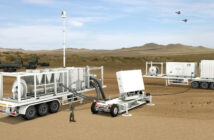John Serafini, CEO of HawkEye 360, has over a decade of experience investing in and leading national security oriented technology companies. John leads the company, which develops space-based radio frequency (RF) collection, mapping, and analytic capabilities. He previously served as Senior Vice President of Allied Minds, where he led the formation, financing and management of HawkEye 360, along with other Allied Minds companies such as BridgeSat, Federated Wireless, and Percipient Networks (WatchGuard acquired). A former Airborne Ranger-qualified US Army infantry officer, John is a graduate of the US Military Academy, Harvard Business School and the Harvard Kennedy School of Government.
JED: Over the past year, HawkEye 360 has launched its fourth and fifth satellite clusters, with a sixth cluster scheduled for launch in December. How many satellites will the company have in orbit by the end of the year, and how will these last few launches improve RF geolocation coverage for customers?
Serafini: So far this year, our satellites and their enhanced capabilities have quadrupled the amount of data we collect to help meet high commercial and government customer demand. With the number of satellites we have on orbit currently, we are able to collect data up to 16 times per day over key regions to provide a new layer of insight for users across the US government, allied governments and commercial and noncommercial partners.
By the end of 2022, with the Cluster 6 launch, we expect to have 15 of our next-gen satellites in orbit. This upcoming flight with Rocket Lab will be the company’s first home state launch on Wallops Island, VA. Cluster 6 will also be the company’s first cluster of satellites to reach an inclined orbit to expand revisits over the mid-latitude range, pushing us below an hourly collection for key regions customers are demanding.
JED: How has HawkEye 360 been able to improve the sensor payloads of each satellite cluster it has launched, and what does this mean in terms of expanding the types of signals you can cover?
Serafini: We follow the SmallSat methodology of incorporating and advancing upon incremental technological improvements over time – or simply put, the crawl, walk, run paradigm. Almost every new set of satellites has enhanced antennas and frequency range options. With the launch of Cluster 6, HawkEye 360 is expanding the collectable range to include 15 to 18 GHz, which unlocks new types of emitters our commercial and government customers may seek to monitor and characterize in their area of interest. We are fast approaching the ability to pick up on many frequency ranges, from VHF to Ku band.
JED: How has the company focused on developing its back-end analytics to provide new services, such as the Dark Ship Maritime Analytics service it introduced earlier this year?
Serafini: Having complete visibility of the space domain enables the optimized use of quality data analytics, which thus optimizes informed decision-making for our customers. We have focused on back-end analytics by offering not only raw I/Q data for RF experts, but also processing emitter geolocations and delivering analytics that describe real-life activity for everyday analysts. Our back-end capabilities enable analysts to contextualize anomalies both on land and at sea to more effectively employ other intelligence gathering tools when needed. This ranges from finding sources of GPS interference in a wartime setting, to locating potential dark vessels trying to disguise illicit activities, to monitoring early-warning radar equipment to augment battlefield awareness.
JED: In July, HawkEye 360 opened a new Advanced Technology and Development Center. How will this new facility improve the quality and speed of your manufacturing process?
Serafini: The opening of our Advanced Technology and Development Center in Herndon, VA, made it possible for HawkEye 360 to streamline and centralize all data engineering and satellite manufacturing in-house, expanding both our workspace and our workforce to continue innovating all aspects of our commercial RF technology. Our new facility hosts constellation operations, data processing, software development, payload development and satellite assembly, all in our home state of Virginia.
The new facility houses our RF electronics labs, as well as a clean room to assemble entire satellites onsite, giving us more control and flexibility over the entire space platform to accelerate the introduction and deployment of new state-of-the-art capabilities.
JED: Over the past year, HawkEye 360 has continued to grow the number and types of customers it serves. How has the company learned from its customers and used this information to either introduce new services or refine some of the existing services it offers to the market?
Serafini: We have solidified lasting partnerships with our customers, commercial and government alike, by better understanding their unique problems and modifying our approach according to their intelligence needs.
We are regularly involved in military exercises. Right now, we have an active US Army Cooperative Research and Development Agreement (CRADA), and we’ve also expanded our research-focused contract with the National Reconnaissance Office to provide high-impact data and operationalize commercial RF intelligence to support and inform warfighters, the Intelligence Community, and policymakers. As we transition into long-term engagements with customers, they are helping us identify how to improve our services every year.
JED: What types of new services is HawkEye 360 planning to offer in the coming years?
Serafini: We are very excited with the upcoming enhancements in 2023 and in the years to come. HawkEye 360 continues to build upon its core initiative to deliver data from our satellites into the hands of customers at greater speeds, for timely regional and maritime awareness. We will be launching additional clusters to accelerate revisit rates, as well as unveiling enhanced collection modes to generate more signal discoveries. On the back-end, we are also researching a signal identification algorithm to maintain custody of vessels over time, bolstering our dark ship detection efforts for proactive visibility into the unknown.






